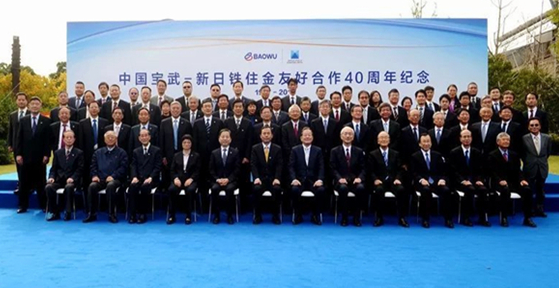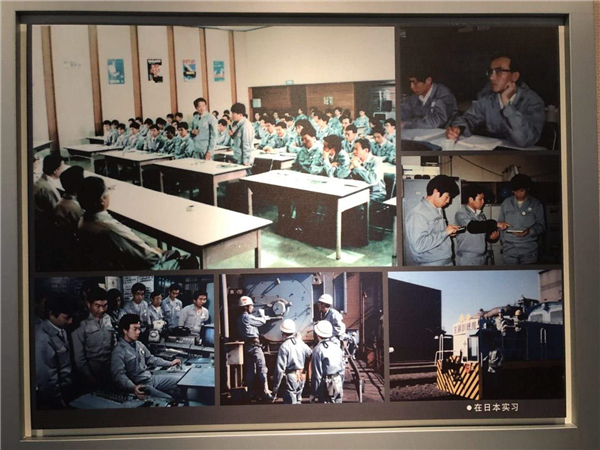Satoshi Murata: progressing with China’s steel industry
The 3rd Plenary Session of the 11th Central Committee of the Communist Party of China held in December, 1978, marked the beginning of the reform and opening up policy in China. It was also in that December that Baosteel came into being, signifying China’s modernization. It was not a historical coincidence but an integral part of the new policy. In 2016, Baosteel, as old as the process of reform and opening up, merged with Wusteel into Baowu group, which is now the second largest steel producer in the world.

(Construction of Baosteel)
Baosteel is not only the epitome of reform and opening up but also an example of Sino-Japanese cooperation. Nippon Steel& Sumitomo Metal Corporation (NSSMC) is a key part of this story.
Progressing with China’s steel industry
As early as May 1977, Tang Ke of the Ministry of Metallurgical Industry visited Deng Xiaoping at Mount Xi and talked about the plan to import equipment along the coast to build a steel factory utilizing oversea’s resources. China used to build factories inland alongside its mineral reserves, so the plan to build along the coast, which was the West’s advance model, was a rather progressive one for China. However Deng welcomed this proposal and ordered a large investment of money on modern devices to build something great. After a long time of planning, inspection and negotiation, China made a deal with Nippon Steel & Sumitomo Metal Corporation and its president Yoshihiro Inayama visited China in November 1977, raising the curtain on this friendship.
On March 19, 1978, the China National Technical Corporation and NSSMC signed an agreement to set up Baosteel in Beijing. On June 28, the two corporations signed the technical agreement with Asashi trading and Sany group and thus began the construction of Baosteel. The first phase of Baosteel benefited from NSSMC’s devices, expertise and the personnel’s systematic training and internship in Japan.
Head of NSSMC Shanghai Representative Office, Satoshi Murata, was sent to Shanghai 3 years ago. Though he has not experienced the 40-year story himself, he is more than familiar with the friendship between NSSMC and Baosteel.

(Satoshi Murata interviewed by eastday.com)
The normalized diplomatic relations between China and Japan was an opportunity that both governments grasped to entrust NSSMC to modernize Wuhan’s 1,700mm hot rolling assembly line.
It represented the beginning of friendship between the two countries. In addition, NSSMC also provided the devices for electric steel assembly lines and offered operations training for Chinese workers. When Deng Xiaoping inspected the Junjin steel factory of NSSMC in October 1978 he said, “I wish to build a steel factory the same as this one.” President Yoshihiro Inayama agreed at that time to give full support to help the construction of Baosteel.
“Baosteel once faced a shutdown crisis but recovered with the Japanese government’s ODA. In September 1985 when Baosteel lit up its first blast furnace, the entire procedure went into full operation in the second year.”

(First blast furnace of Bao Gang kindled in 1985)
The partnership that has lasted for 40 years will continue, as Murata predicts that the high-end automobile industry’s demand for steel is on the rise. In 2005 the two companies founded BNA especially to meet the demand for steel plates. In 2010, NSSMC set up another company with Wuhan Steel to concentrate on tinplate. On November 4 last year, the 40th anniversary of NSSMC-Baowu partnership was celebrated.

(40th anniversary of NSSMC-Baowu partnership)
“I think NSSMC and the steel industry of China after reform and opening up are growing together. The 40th year is not an end but a new starting line of closer partnership.”
Amazed at China’s technological advancement and balanced growth
Satoshi Murata arrived in Shanghai in April 2015 before serving as the manager of Chugoku Chiho in Hiroshima. Upon his arrival in Shanghai he discovered that it was different from his impression of China in Japan, and that Shanghai is as prosperous as Tokyo.
Murata feels that Shanghai is a great city to live in. He also loves Chinese cuisine, saying that the cuisines of Szechuan, Hunan and Shanghai are all his favorites. He is most impressed by China’s policy implementation capability over his stay in Shanghai. For instance, the policies of banning fire crackers and honking have beene extremely successful. In his field, he gives credit to China for efficiently reducing the surplus in productivity.“China’s implementation is far superior to that of Japan,” says Murata.
Regarding the biggest change brought by the reform and opening up, Murata blurted out, “advancement in technology”. From the perspective of the steel industry where he works, China can now produce most of the steel needed by a lot of industries, while only 10 years ago China had to import steel for some demanding fields.
Murata posits that in the early stage of reform and opening up, China introduced a lot more advanced devices and technologies from other countries. Now it is catching up and beginning to innovate on its own. It is these efforts that have enabled China to take off in many fields and avoid overdependence on imports.

(Chinese technicians being trained in NSSMC)
Another term that Murata mentioned is “balanced development.” “The overall growth over the years has been significant, reaching a peak in 2008 and transitioning to stable growth after 2015, which China calls the ’new norm’,” says Murata. Despite the rapid rate of growth, there are a few issues remaining such as inequality, financial problems, the price of real estate and environmental issues. China is actively tackling these issues and seeking a balance in crafting the best solution to all these problems.

(Satoshi Murata sends words for China's reform and opening up: the bond of steel)
On the deepening reform and opening up of society and the economy, Murata also gave his suggestion and expectation. “China is already a great power, giving the policies and actions of the state great influence above the interests of private enterprises. We look forward to China taking up the self-awareness and confidence as the world’s leader and making contributions for global development.”
